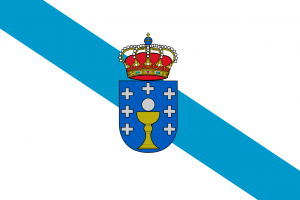Language/Galician/Grammar/Basic-Sentence-Structure
| ◀️ The Galician Alphabet — Previous Lesson | Next Lesson — Numbers 1-10 ▶️ |
Introduction[edit | edit source]
Welcome to the lesson on basic sentence structure in Galician! In order to communicate effectively in any language, it is crucial to understand how sentences are formed. In this lesson, we will explore the fundamental components of a sentence in Galician, including the subject, verb, and object. Understanding these elements will lay a solid foundation for your Galician language journey and enable you to construct simple sentences with ease.
To ensure a comprehensive learning experience, this lesson will provide detailed explanations, numerous examples, and engaging exercises. You will also discover interesting cultural facts about Galicia, including regional variations in sentence structure and historical influences on the language. So, let's dive in and explore the fascinating world of Galician sentence structure!
The Basic Sentence Structure[edit | edit source]
In Galician, the basic sentence structure follows a Subject-Verb-Object (SVO) pattern. This means that a sentence typically consists of a subject, a verb, and an object. Understanding the role of each component is essential for constructing grammatically correct sentences. Let's delve into each element in more detail:
Subject[edit | edit source]
The subject is the main noun or pronoun that performs the action of the verb in a sentence. It answers the question "Who or what is doing the action?" In Galician, the subject usually comes before the verb.
Here are some examples of subjects in Galician sentences:
- "O gato durme." (The cat sleeps.)
- "Eles estudan." (They study.)
- "A profesora fala." (The teacher speaks.)
In these examples, "o gato" (the cat), "eles" (they), and "a profesora" (the teacher) are the subjects.
Verb[edit | edit source]
The verb expresses the action or state of being in a sentence. It indicates what the subject is doing or experiencing. In Galician, verbs are conjugated to match the subject in terms of person and number.
Here are some examples of verbs in Galician sentences:
- "Eu falo." (I speak.)
- "Ti cantas." (You sing.)
- "El come." (He eats.)
In these examples, "falo" (speak), "cantas" (sing), and "come" (eat) are the verbs.
Object[edit | edit source]
The object is the noun or pronoun that receives the action of the verb in a sentence. It answers the question "Who or what is being acted upon?" In Galician, the object typically comes after the verb.
Here are some examples of objects in Galician sentences:
- "Eu leo un libro." (I read a book.)
- "Ela compra froitas." (She buys fruits.)
- "Nós vemos a televisión." (We watch TV.)
In these examples, "un libro" (a book), "froitas" (fruits), and "a televisión" (the TV) are the objects.
Regional Variations and Cultural Insights[edit | edit source]
Galicia, located in the northwest corner of Spain, has its own distinct dialect and cultural nuances. While the basic sentence structure remains the same throughout Galicia, there are some regional variations in vocabulary and pronunciation. For example, in coastal areas, you might hear more influence from the Portuguese language due to historical connections with Portugal. Inland areas, on the other hand, may have more Castilian Spanish influences.
Historically, Galician has faced challenges and restrictions, particularly during the Franco regime, which suppressed the use of regional languages. However, in recent years, there has been a resurgence of Galician pride and efforts to preserve and promote the language. Today, Galician is an official language in Galicia, and there are various cultural events, literature, and music that celebrate the rich Galician heritage.
Exercises[edit | edit source]
Now it's time to put your knowledge into practice! Complete the following exercises to reinforce your understanding of basic sentence structure in Galician. Solutions and explanations will be provided afterward.
Exercise 1: Identify the Subject, Verb, and Object For each sentence, identify the subject, verb, and object.
1. O neno xoga coa pelota. (The boy plays with the ball.) 2. Vós falades moi ben. (You speak very well.) 3. Ela escribe unha carta. (She writes a letter.)
Exercise 2: Create Sentences Create three sentences in Galician using the SVO structure. Feel free to choose your own subjects, verbs, and objects.
Solutions[edit | edit source]
Exercise 1: Identify the Subject, Verb, and Object 1. Subject: O neno (The boy); Verb: xoga (plays); Object: coa pelota (with the ball). 2. Subject: Vós (You); Verb: falades (speak); Object: moi ben (very well). 3. Subject: Ela (She); Verb: escribe (writes); Object: unha carta (a letter).
Exercise 2: Create Sentences Example sentences may vary. Here are some possible sentences:
1. Eu estudo libros. (I study books.) 2. Nós comemos froitas. (We eat fruits.) 3. Ti ves a televisión. (You watch TV.)
Congratulations! You have successfully completed the exercises. Now you have a solid understanding of the basic sentence structure in Galician.
Conclusion[edit | edit source]
In this lesson, you have learned about the basic sentence structure in Galician, including the subject, verb, and object. Remember that Galician follows an SVO pattern, where the subject precedes the verb, and the object follows the verb. By mastering the SVO structure, you will be able to construct simple sentences and express yourself in Galician with confidence.
Continue practicing and exploring the fascinating Galician language. In the next lessons of the "Complete 0 to A1 Galician Course," we will delve deeper into the intricacies of Galician grammar, vocabulary, and culture. Enjoy your journey and embrace the beauty of Galicia!
Sources[edit | edit source]
Other Lessons[edit | edit source]
- Definite Articles in Galician
- Adjective Agreement
- Subject Pronouns
- Present Tense
- Questions
- Be Polite
- 0 to A1 Course
- Plurals
- The Galician Alphabet
| ◀️ The Galician Alphabet — Previous Lesson | Next Lesson — Numbers 1-10 ▶️ |

